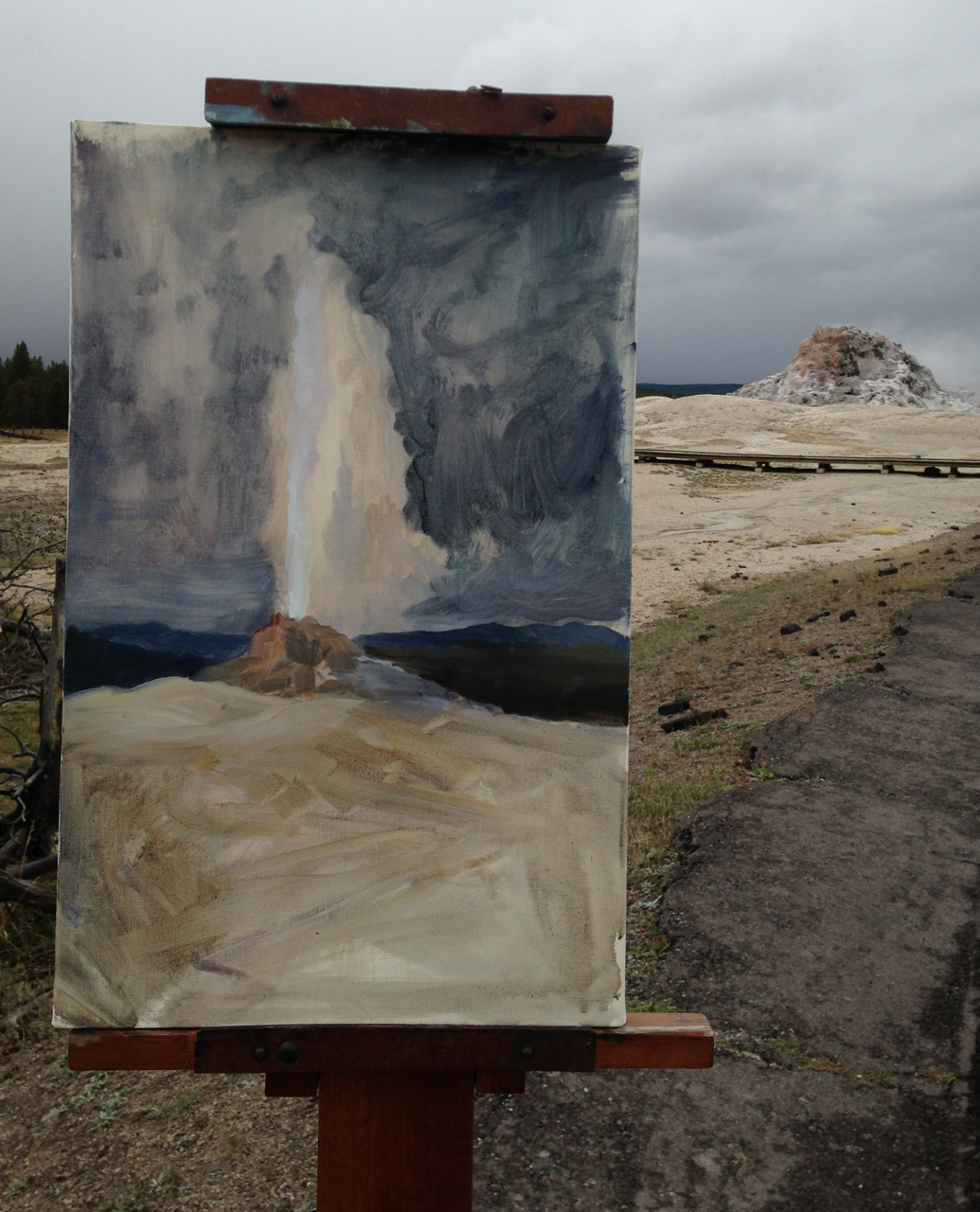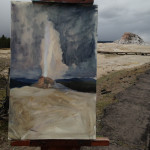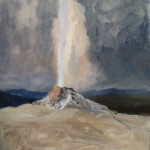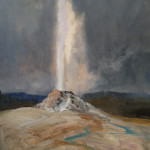“Yellowstone Geyser, Primary Sketch” by Stefan Baumann
Three Keys to Plein Air Success, Inspiration, Composition & Application, Part 2
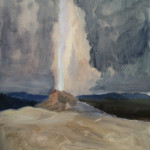
Composing with the Geyser slightly to left side, to create movement with shapes of cone, spout, and sense of place included.
Inspiration
As demonstrated by painting a geyser in Yellowstone National Park, an artist must first be inspired by an idea, feeling or vision of what he wants to communicate with the viewer about the scene or location before applying any paint to the canvas. The source of inspiration may be the effect of light in the scene, or a feeling created by the lighting or the time of day, or it might come from several objects in a location that come together to tell a story or create a mood that speaks to the viewer. When an artist has an idea that inspires him to want to paint what he sees and feels, he is ready to begin painting a geyser.
Composition
I began my composition by applying a thin layer of transparent paint all over the canvas. Then, using a paint brush with transparent paint and a paper towel, I sketched in shapes and darker values and wiped off shapes and areas that needed to be lighter including my focal point which is the brightest spot. This preliminary composition allows me to freely wipe off, move or add more paint and not worry about having too much paint that can become muddy. I used the golden ratio and golden means to help me locate and place objects in the scene in the most pleasing places that contribute to the movement, balance and location of the central focal points in the painting. By paying close attention to my composition, I placed the main spout of water exploding out of the ground in the center, and positioned the geyser so that it is slightly off-center to create movement in the painting.
Paint Application
When painting on location, the light changes very quickly, and in this particular scene, the amount of time that an artist has to observe and paint the geyser while it erupts is only about 3 minutes. I began applying the paint to the preliminary sketch by adding several lines of thinly painted dark values at various places near the geyser so that the dark paint could contrast with the light, hue and chroma and enhance the vitality of the foreground. Next, I used thin washes to create footnotes where I wanted to locate the contrasts of light and dark values. Then, I painted in the values and contrasting lights and dark, and painted the details of the cone of the geyser and the spout of water erupting from the cone. I usually work from the main focal point out to the canvas edges to avoid overworking the painting, and in this painting, the effect of light on the geyser captures the attention of the viewer’s eye and is my main focal point.
Finally, I painted the sky and the background with thin paint, and lightened the values of the mountains so they appear to recede in the distance. To complete the sky, I added a thicker layer of paint to my thinly painted sketch. I did this by adding white to my gray mixture. I believe that if I want to have the sky look like it is part of the painting and not just a backdrop, every inch of the sky must go through constant transitions from dark to light and warm to cool. When I completed the sky, I painted the highlights in the clouds a bit less bright than the geyser’s highlights so that they didn’t distract the main focal point. The water channels or little rivers that were created by the water that came up from the ground intentionally lead to the cone, to draw the viewer’s into the painting and towards the cone. Artists use these lines called “eye magnets,” to focus the viewer’s attention in and around the painting and towards the focal points. The blue and white lines that lead into the foreground and towards the cone of the Geyser in this painting are among the most important and integral tools used to create a strong composition.
_________________________________________________________________________________
Plein air and Alla Prima artist Stefan Baumann, host of the PBS painting series “The Grand View, America’s National Park through the eyes of an artist” and author of “Observations Of Art and Nature,” travels in his vintage travel trailer painting America’s western landscape. Baumann paints outdoors with oils and canvas capturing stunning vistas, wildlife, western landscapes, National Parks and still life, thrilling art collectors throughout the world. He has many international collectors acquiring his paintings as investments. His painting style is called Romantic Realism with Luminism, and the extraordinary way he captures the effect of light is a truly an American style used to paint the Western landscape. He can be seen painting in Yellowstone, Yosemite and Grand Canyon National Parks. Baumann’s “how to paint” DVDs, filmed on location in the National Parks, are the very best on the art instruction market.

